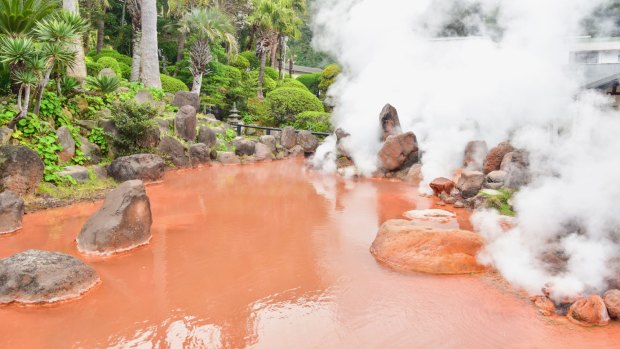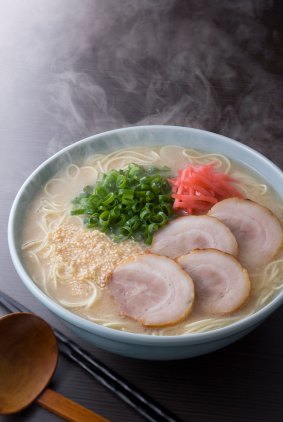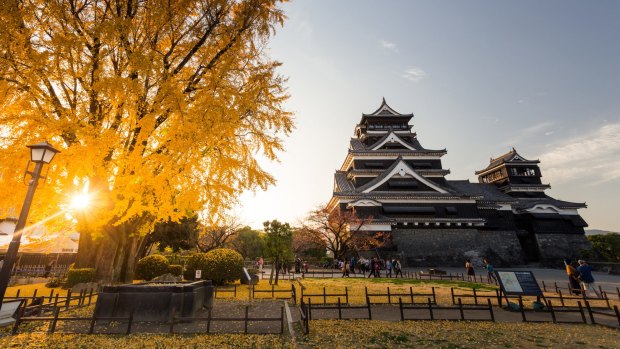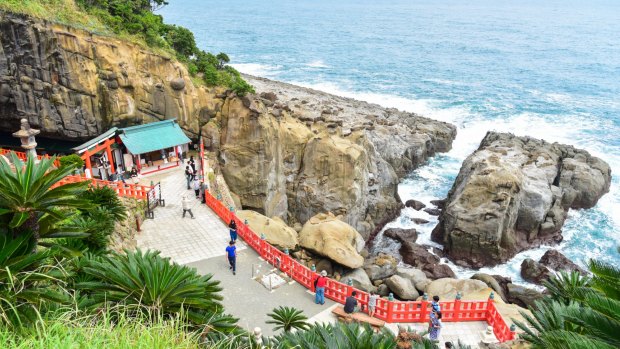This was published 5 years ago
Travel tips and things to do in Kyushu, Japan: 20 reasons to visit
By Louise Southerden

Blood Pond Hell can be found in the city of Beppu in north-eastern Kyushu.Credit: Shutterstock
1. EAT FAMOUS HAKATA RAMEN
Fukuoka, the largest city in Kyushu, is the ramen capital of Japan, famous for its Hakata ramen, whisper-thin noodles served in a collagen-rich pork-bone broth. Head for one of the yatai stalls set up on city centre footpaths every evening or slurp your ramen solo in a one-person "flavour concentration booth" at Ichiran, a noodle chain founded in Fukuoka that now has restaurants across Japan. en.ichiran.com
2. ROW YOUR OWN BOAT

Fukuoka, the largest city in Kyushu, is the ramen capital of Japan, famous for its Hakata ramen.Credit: Sourcenext / Alamy Stock Photo
Takachiho Gorge in central Kyushu is one of the most picturesque places in Japan, particularly in autumn (mid to late-November in Kyushu). There's a one-kilometre walking trail along the rim of this lava-walled chasm, but the best way to experience it is by rental row boat, drifting close to the dark basalt walls under veils of spray falling from above. japan-guide.com
3. WATCH WORLD-CLASS RUGBY
When Japan hosts the third-largest sporting event in the world next year (after the summer Olympics and the FIFA World Cup), three of the 12 host cities will be in Kyushu: Oita, Fukuoka and Kumamoto will all host matches between September 20 and November 2, 2019. The Wallabies play Uruguay on October 5 at Oita stadium, which is also hosting two quarter-finals on October 19 and 20. visitjapan2019.com

Kumamoto Castle in central Kyushu.Credit: Shutterstock
4. BLOW OFF STEAM
Sakurajima in southern Kyushu is one of the world's most active volcanoes, regularly spewing volcanic ash onto nearby Kagoshima city. For up-close volcano views you're spoiled for options: catch a ferry across the bay to Kagoshima, drive around the island-volcano stopping at lava fields, soak your feet in a 100-metre outdoor footbath, swim at an artificial beach or bathe in the aptly named Magma Onsen. There's also an excellent volcano museum at the visitor centre. sakurajima.gr.jp/svc/english/
5. TAKE A SERIOUS HIKE

There are hundreds of Shinto shrines across Kyushu but Udo Shrine in Miyazaki prefecture is one of the most beautiful.Credit: Shutterstock
Kyushu offers some of the best boots-and-all hiking in Japan. Two of the best spots are Kirishima-Kinkowan National Park for its volcanoes and crater lakes; and the relatively unknown Kunisaki Peninsula, where a 10-day trek will take you along craggy ridges and through ancient forests. You probably won't see any other trekkers and every day ends with a soak in an onsen at a local inn. walkjapan.com
6. STAY IN A HILLSIDE VAN
Overlooking a popular surf spot south of Miyazaki in southern Kyushu, Cinema Heaven is a gem of a place created by a local surfer couple. What started as a teepee on a hill has grown into two Airstream caravans (¥20,000 a night), an organic cafe inspired by surf trips to Mexico, a shipping-container art gallery and surf shop and a deck for yoga, casual concerts and weekly movie nights. cinema-heaven.com
7. GET ARTY, OUTDOORS
Kirishima Open-Air Museum is the MONA of Kyushu, a world-class contemporary art museum in the mountains outside Kagoshima in central Kyushu. The space-station-like main building has two galleries (don't miss the Yoko Ono sculpture) and a cafe with sky-high glass walls, surrounded by 20 hectares of parkland and forest where 23 installations by Japanese and international artists showcase the region's natural beauty. open-air-museum.org
8. CATCH A WAVE
Kyushu's east coast cops typhoon swells between July and October, but there can be waves year-round anywhere between Hyuga and Cape Toi. Just look for the vans with surfboards strapped to the roof or check out the Phew! Hyuga website, with illustrations by a Sydney-based Swedish surfer, which has information about surf spots, surfboard rental and things to see and do in Hyuga. phew-hyuga.jp
9. BE BLESSED
There are hundreds of Shinto shrines across Kyushu, where the first gods are believed to have descended to Earth, but Udo Shrine in Miyazaki prefecture is one of the most beautiful. Stone steps with burnt-orange railings lead down to the base of a cliff by the sparkling blue sea. Inside a large cave is the shrine, but pause outside to toss a pebble (¥100 buys you five) onto a seaside boulder. If it lands inside the rope circle on top, you'll be blessed in love and childbirth.
10. DRIVE ALONG THE COAST
Japan is one of the easiest places to self-drive – road signs are in English as well as Japanese, you drive on the left and Japanese drivers are ridiculously courteous. Kyushu has dozens of spectacular drives, such as the coast-clinging Route 220 that snakes south from Miyazaki to Cape Toi lighthouse, where wild horses roam. See Kyushu Tourism's website for other routes. welcomekyushu.com/kyushu-road-trip/
11. GIVE PEACE A CHANCE
As well as commemorating the solemn event of August 9, 1945, Nagasaki's Atomic Bomb Museum is also a monument to peace. It explains the events leading up to the bombing and the rise of the subsequent nuclear non-proliferation and peace movements. Entry is ¥200 and includes a free origami crane souvenir. nagasakipeace.jp
12. GET VOLCANIC
Aso-san in central Kyushu is one of the world's largest volcanic calderas, a vast open bowl dominated by very un-Japanese pampas grass plains where you can take guided horse treks. Some of the surrounding peaks are still active. Nakadake erupted in 2016. Kai Aso boutique hotel on the northern rim of the caldera has some of the best views and private outdoor onsens. kai-ryokan.jp/en/aso
13. BE SPIRITED AWAY
Sake might be Japan's national drink, but shochu is more popular, particularly in Kyushu where it arrived in the 16th century. Honkaku Shochu Bar in Kagoshima has more than 1500 locally made brands of this whisky-like spirit made from rice, barley or sweet potatoes. Try it straight, on the rocks, mixed with warm water or with lemon soda and ice for a refreshing "chuhai". honkakushochu-bar-ishizue.com
14. INDULGE IN ONSEN
Known as "onsen island", Kyushu has more hot springs than anywhere else in Japan. There are onsens with volcano views, by the sea, in the mountains. There are hot spring towns such as Yufuin, Kurokawa Onsen and Kirishima Onsen where you can get around in cotton yukata and wooden thongs. At Saraku Sand Bath Hall in Ibusuki, you can even be buried up to your neck in black sand heated by underground steam vents. sa-raku.sakura.ne.jp
15.GO DUTCH
Twice as big as Tokyo Disneyland, Huis Ten Bosch ("House in the Woods", named after a Dutch royal residence) in northern Kyushu is so much more than a Dutch theme park. Sure it has traditional European-style hotels, restaurants, museums, windmills and gardens, but also, bizarrely, an owl forest, gondola rides, high-tech light shows, a massive water park, virtual reality experiences galore – even an illuminated ice skating rink. See english.huistenbosch.co.jp
16.SLEEP WEIRD
Kyushu has more than its fair share of unusual places to stay, including the world's first hotel staffed by robots in Huis Ten Bosch; Japan's first smart hostel in Fukuoka where guests control room features via smartphone; and WeBase Hakata, also in Fukuoka, a marine-themed hostel with "cabins" and a gigantic "ship's cat" sculpture at its entrance. h-n-h.jp/en/; andhostel.jp/fukuoka/; we-base.jp
17. LAND ON A FAIRYTALE ISLAND
The small mountainous island of Yakushima, a short ferry ride or flight from Kagoshima in southern Kyushu, is another world of fairytale cedar forests (some of these yakusugi trees are thousands of years old), natural hot spring pools by the sea, hiking trails (you can cross the island in three days, staying in free huts en route) and wildlife such as macaques, deer and nesting loggerhead turtles. yakumonkey.com
18.CHANNEL THE LAST SAMURAI
Kumamoto Castle in central Kyushu was one of the last stands of the samurai at the start of Japan's Meiji era in 1877. Partially damaged by earthquakes in 2016, it's still awe-inspiring, particularly in cherry blossom season. For another "last samurai" experience, Ishidake lookout near Sasebo in northern Kyushu is where scenes from the 2003 Tom Cruise movie were shot, overlooking Kujukushima ("99 islands"). See travel.sasebo99.com/en/
19.GO TO "HELL"
One of the main hot spring areas in Japan, the city of Beppu in north-eastern Kyushu has almost 3000 hot spring vents but it's best known for its "hells", eight glumping mud pools too hot to bathe in, all with evocative names such as Blood Pond Hell (minerals make the water red) and Shaven Head Hell (the mud bubbles look like bald monks' heads). See beppu-jigoku.com
20.TAKE A SEVEN-STAR TRAIN
Billed as the world's most luxurious train, the Seven Stars "cruise-train" has 14 Orient Express-style suites starting at ¥630,000 ($7500) a person for a four-day, 3000-kilometre lap of Kyushu's seven prefectures, including dinners at some of Kyushu's finest French as well as Japanese restaurants and one night at a lakeside ryokan. ruisetrain-sevenstars.jp/english/
Louise Southerden travelled courtesy of Walk Japan and Kyushu Tourism.
Sign up for the Traveller Deals newsletter
Get exclusive travel deals delivered straight to your inbox. Sign up now.